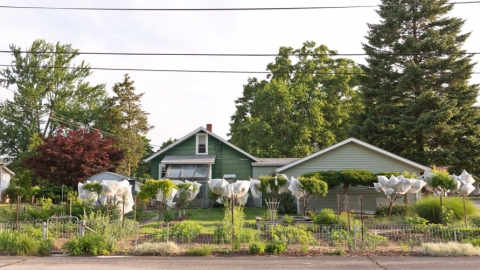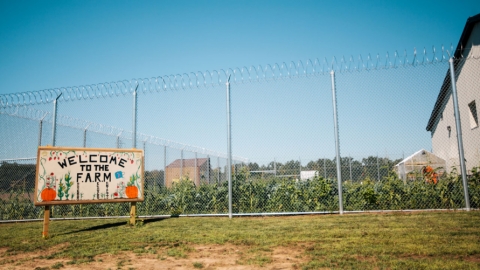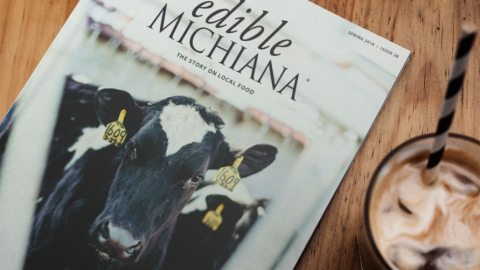Compost: Reduce household waste and nourish the earth
I am a compost wallflower.
Oh sure, I rake up leaves and fling them on the vegetable garden during the fall, and we toss our daily cooking scraps to our small flock of chickens, but I have yet to get out on the dance floor with a sincere composting plan.
Even so, I am a firm believer in using compost in the home landscape and garden. I have friends with much smaller yards who are composting wizards. In the summertime, their patio pots are filled with compost and their tomatoes are huge. Their sidewalks are swinging and swaying with nonstop bloomers.
That’s because compost benefits anything that grows. It helps aerate soil and can improve water retention. It also improves the fertility of the soil and promotes healthy root development.
You can use compost to augment soil in a new garden bed in the spring to give plantings a jumpstart. Planning to add a tree or shrub to your landscape in the future? The compost you begin now can be added to the existing soil in the planting hole to give the roots a place to move and groove. You can sprinkle shovels full of compost around the base of established trees, shrubs and perennials for their continual nourishment.
How it works
Known in some circles as “black gold,” compost is natural decomposition at its finest. When you combine dry materials (leaves, straw, pine needles, shredded newspaper, tubes from toilet paper and paper towel rolls, cardboard egg cartons)
with wet materials (coffee grounds, grass clippings, fruit and vegetable scraps) and let those ingredients get to know each other in close quarters, a chemical dance ensues.
The high carbon content of the dry materials and the high nitrogen content of the wet materials come together in a hot tango, with the help of beneficial microorganisms, enzymes and fungi. Mother Nature choreographs this performance without humans getting involved, but our excess tomatoes, banana peels and eggshells are welcome partners.
Why compost
Is composting really worth your time? Isn’t it much easier to toss that leftover salad and days-old pizza into the trash and send it to the landfill?
Easier, yes. Smarter, no.
According to the United States Environmental Protection Agency, “Food scraps and yard waste together currently make up more than 28 percent of what we throw away, and should be composted instead. Composting keeps these materials out of landfills where they take up space and release methane, a potent greenhouse gas.”
Christine Maloney, an advanced permaculture designer and educator in Valparaiso, IN, keeps this concept very simple: “If it comes from the earth, it should go back to the earth.”
How to compost
Maloney has composted more than 14,000 pounds of food and paper waste in her own yard over the past six years. Her home system involves a series of five wooden pallet bins, about 3 feet high, into which she puts practically everything you can think of (check out the link on the top of page 16 to the EPA’s compost guide).
She says there are lots of ways to compost, including putting some food scraps in your kitchen blender. Add a little water, press any button and give it a big twirl. The “smoothie” you’ve just created can be poured on your lawn or garden, where it will seep into the soil. Air, sun and precipitation should quickly break down anything remaining on top.
Maloney also recommends digging a trench or pit about a foot deep in your yard, where you can deposit food, paper waste and yard materials in layers year-round, little by little each day. Minute creatures in the ground will flash mob your offerings and eventually turn them into rich compost.
The hardest part of larger volume composting is probably patience. Think slow dance, not hip hop. If your bin or trench is full, with a good variety of wet and dry ingredients, you should see finished compost in a month or so, with wide variations. (Decomposition occurs more quickly in the warmer months, and slows during the chilly seasons.)
You can benefit from compost even if its preparation doesn’t fit into your routine. Some communities have started to offer finished compost, sometimes absolutely free, as part of their yard waste recycling program. The city of South Bend, for example, uses curbside bins (rented by residents) to gather yard waste and small brush that are then composted at the city’s Organic Resources facility. Check with your local municipality to see what options are available.
It’s all a matter of scale. Maybe first experiment with a batch of blender compost to enrich your lawn, or dig a small trench alongside your garage to watch things get down and funky.
A few tentative steps like these could seriously reduce the conga line of waste heading to the landfill.












